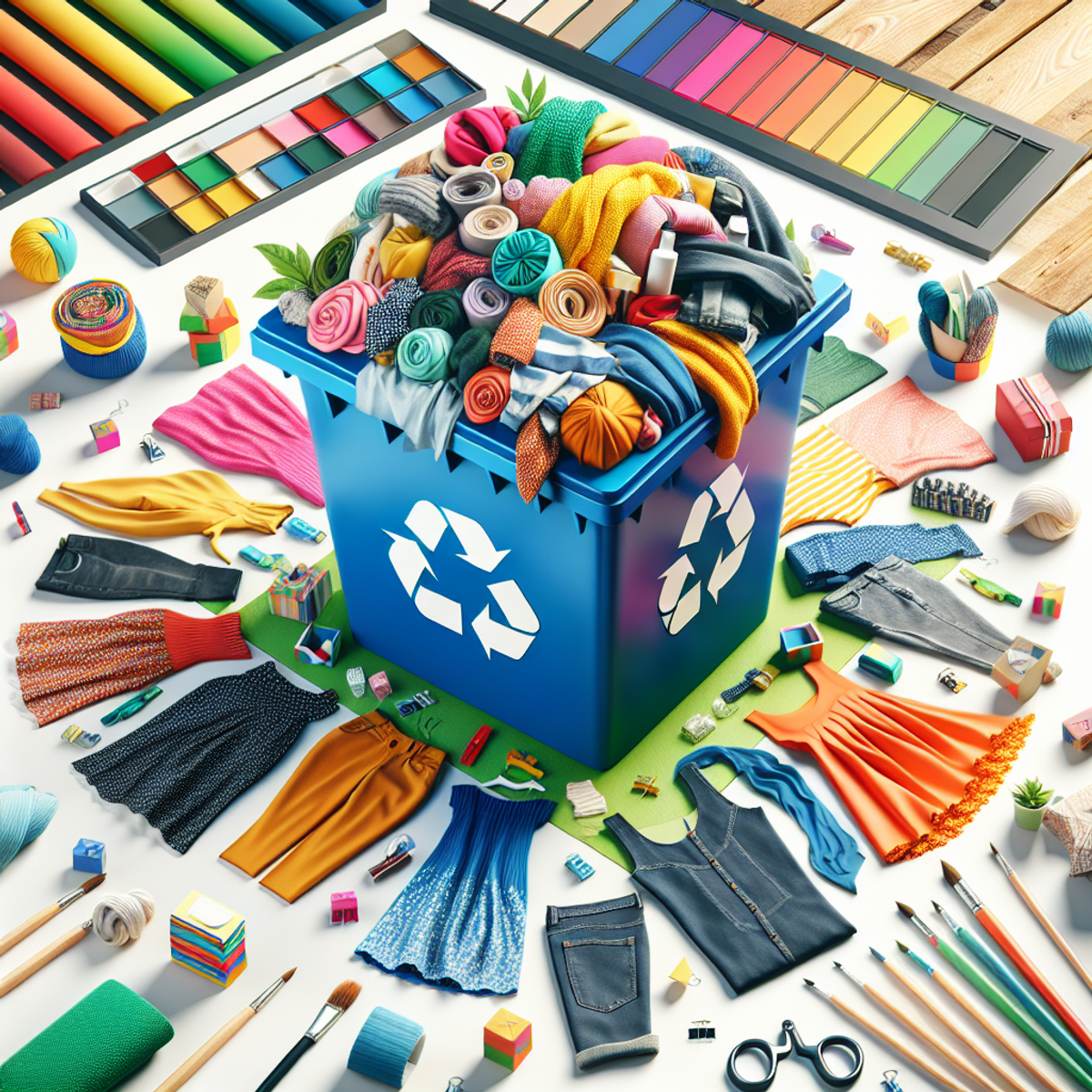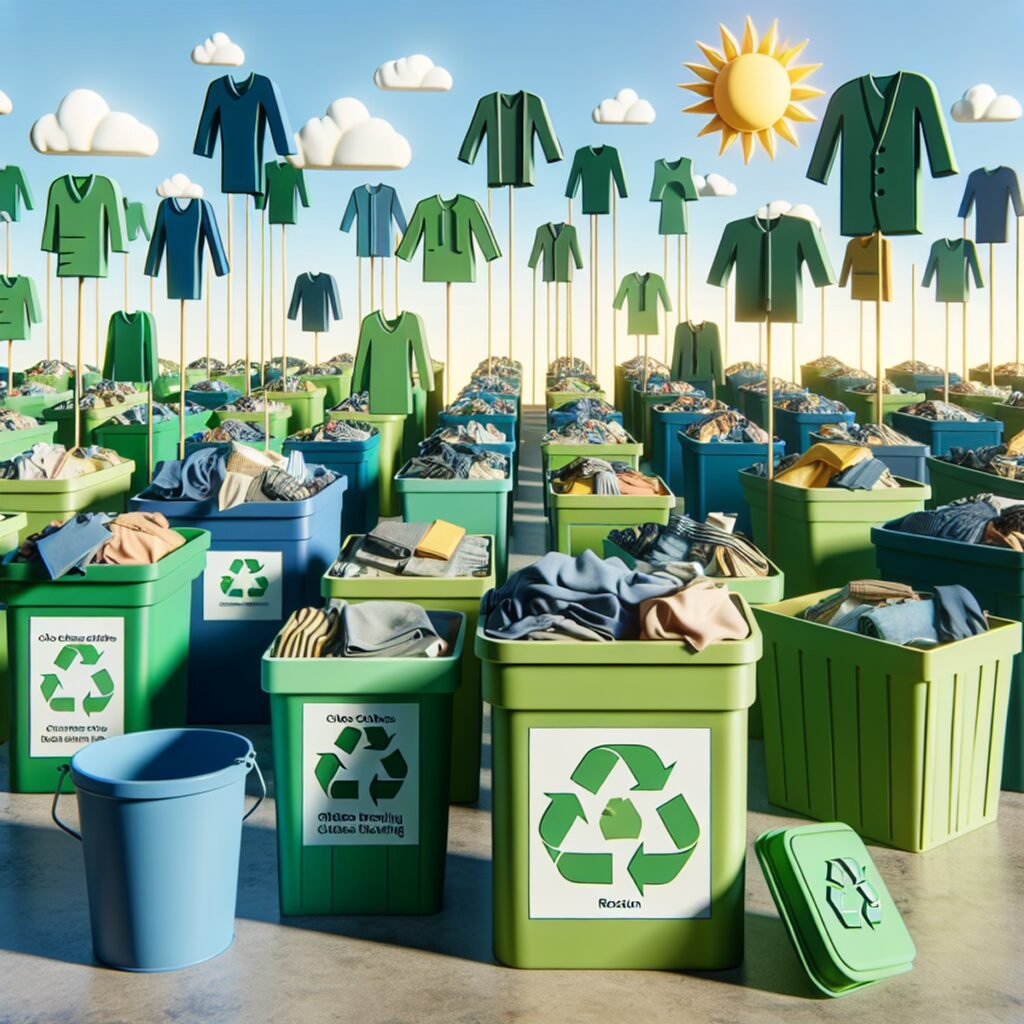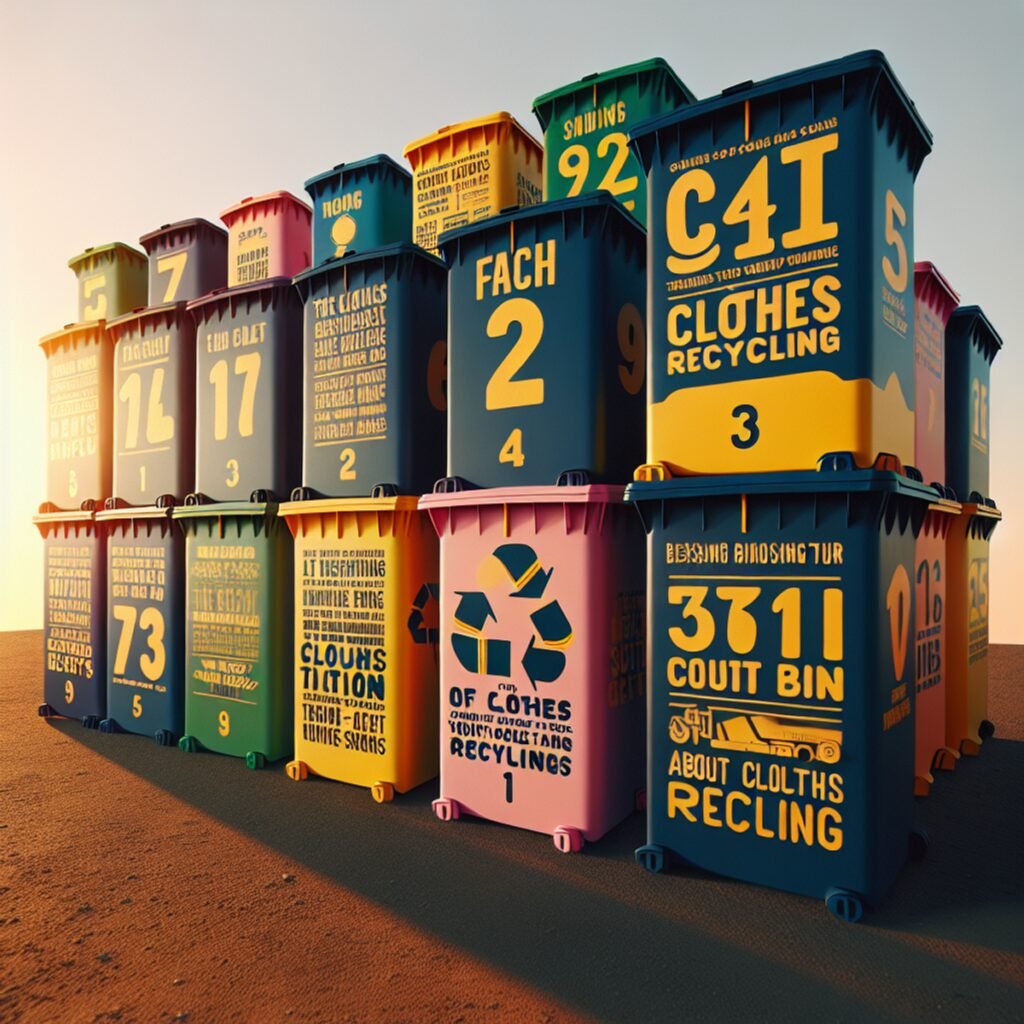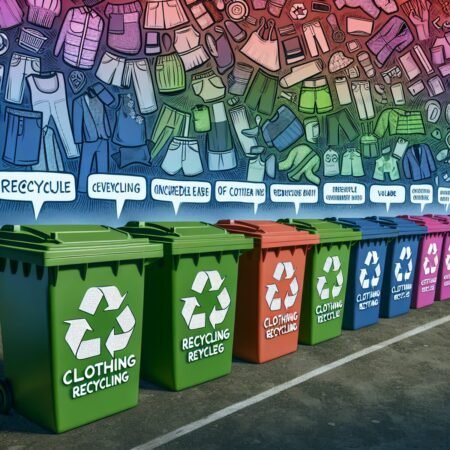
1. The Growing Need for Clothes Recycling Bins
Clothes recycling bins have become an essential part of addressing the increasing problem of textile waste. These bins provide a convenient and eco-friendly solution for disposing of unwanted clothes and shoes. Here are some key points to consider:
- What are clothes recycling bins? Clothes recycling bins are specially designed containers where individuals can deposit their old or unwanted clothing items. These bins are typically found in public spaces, such as shopping centers, schools, and community centers.
- How do they work? When you have clothes that you no longer need, you can simply drop them into the bin. These bins are specifically designed to collect clothing, shoes, and accessories for recycling purposes.
- The problem of textile waste: The fashion industry is one of the largest contributors to global waste production. Textile waste poses significant environmental challenges due to its non-biodegradable nature and harmful chemical content. Traditional disposal methods, such as landfilling or incineration, contribute to pollution and resource depletion.
- Importance of proper disposal methods: Recycling bins play a crucial role in diverting textile waste from landfills. By using clothes recycling bins, you can ensure that your old clothes are given a second life through recycling or repurposing.
- Addressing the need: As more people become aware of the environmental impact of fast fashion and the importance of sustainable practices, the demand for clothes recycling bins has grown significantly. Individuals and communities are actively seeking ways to reduce their carbon footprint and contribute to a circular economy.
By utilizing clothes recycling bins, we can collectively make a positive impact on reducing textile waste and building a more sustainable future.
2. Key Benefits of Using Clothes Recycling Bins

When it comes to addressing the increasing problem of textile waste, clothes recycling bins play a crucial role. These bins offer numerous benefits that not only promote responsible consumption and disposal habits but also contribute to a more sustainable fashion industry. Let’s take a closer look at some key benefits of using clothes recycling bins:
1. Encourages responsible consumption and disposal habits
Clothes recycling bins provide a convenient solution for individuals to recycle their old clothes and shoes instead of throwing them away. By making recycling easily accessible, these bins encourage people to think twice about their clothing choices and dispose of unwanted items responsibly.
2. Conserves valuable resources
The production of new textiles requires significant amounts of water, energy, and raw materials. By recycling clothes through dedicated bins, valuable resources can be conserved. Recycling one ton of clothing can save around 3,500 liters of water and reduce carbon emissions by approximately 3 tons.
3. Reduces the need for landfill space
Textile waste takes up a considerable amount of space in landfills. By recycling fabrics through clothes recycling bins, the need for landfill space is significantly reduced. Recycled textiles can be turned into new products, extending their lifespan and minimizing waste.
“By utilizing clothes recycling bins, individuals can actively participate in reducing textile waste and promoting sustainable fashion practices.”
3. The Role of Clothes Recycling Bin Franchise in Promoting Sustainable Fashion

The Clothes Recycling Bin franchise offers a unique business opportunity with both environmental and economic benefits. This franchise model not only allows individuals to control their destiny and be successful but also contributes to environmental sustainability through its innovative approach.
- The concept of the Clothes Recycling Bin franchise offers a business model that combines profit-making with sustainable practices.
- It provides a low initial investment and scalability, making it attainable and profitable for individuals seeking to make a difference in promoting green environments.
4. Acceptable Items for Recycling in Clothes Recycling Bins
When utilizing clothes recycling bins, it’s crucial to understand which items can be recycled. These bins are specifically designed to handle a wide range of clothing items, shoes, and accessories, contributing to the circular fashion economy that emphasizes sustainability.
Consider the following key points:
- Clean and dry clothing: Clothing in good condition without stains or odors is generally accepted in recycling bins. This includes shirts, pants, dresses, jackets, and sweaters. It’s important to wash and dry these items before placing them in the bin.
- Paired shoes: Wearable shoes in decent condition can also be donated through the recycling bins. Remember to pair both shoes together before dropping them into the bin. If you’re unsure about how to recycle shoes appropriately, this guide from Shoe Zone might prove helpful.
- Wearable accessories: Accessories such as belts, scarves, hats, and handbags can often be recycled as well, provided they are in good condition without significant damage.
It’s worth noting that heavily damaged or soiled textiles may not be suitable for recycling through these bins. In such cases, consider donating them to local charities or thrift stores instead. This way, if they can be repaired or repurposed, you extend the lifespan of these items and further reduce waste. You may find this resource from Earth911 useful when exploring other options for recycling clothes.
By adhering to these guidelines and only donating acceptable items, your contributions will have a positive impact on the environment. Every item recycled through these bins helps conserve valuable resources and reduces the need for landfill space. If you’re looking for more information on proper waste disposal, the Howard County Bureau of Environmental Services offers additional resources.
5. Impact of Clothes Recycling Bins on Landfill Waste Reduction

Clothes recycling bins play a significant role in diverting textile waste from ending up in landfills. Here are some key points on how these bins contribute to landfill waste reduction:
- Preventing clothing from going to landfills: The majority of discarded clothing ends up in landfills, where it contributes to the growing problem of textile waste. By providing a convenient and accessible way for people to recycle their unwanted clothes, recycling bins help divert these items away from landfill sites.
- Extending the lifespan of textiles: Instead of being discarded as waste, clothes that are deposited in recycling bins have the potential to be reused or repurposed. These items can be sorted, repaired, or transformed into new products, reducing the demand for newly manufactured textiles and extending the lifespan of existing garments.
- Reducing greenhouse gas emissions: When textiles decompose in landfills, they release methane, a potent greenhouse gas that contributes to climate change. By diverting textiles from landfills through recycling bins, we can significantly reduce the amount of methane emissions and mitigate their environmental impact.
- Conserving valuable resources: The production of textiles requires significant amounts of water, energy, and other resources. By recycling clothes instead of producing new ones, we can conserve these valuable resources and reduce the environmental footprint associated with textile manufacturing.
- Creating economic opportunities: Recycling old clothes not only benefits the environment but also creates economic opportunities. The textile recycling industry generates jobs in sorting, processing, and repurposing textiles, contributing to local economies while reducing waste.
By utilizing clothes recycling bins, individuals and communities can make a tangible impact on reducing landfill waste and promoting a more sustainable approach to fashion consumption. These bins provide a simple yet effective solution for diverting clothing from landfills and helping to build a circular economy for textiles.
Join the movement and embrace sustainable fashion by utilizing your local clothes recycling bins to recycle your unwanted clothes and spread awareness about the importance of circular fashion.
6. Engaging the Community with Clothes Recycling Initiatives

Partnering with local organizations to install and maintain recycling bins in the community is crucial for the success of clothes recycling initiatives. These partnerships help to:
- Expand the reach and impact of recycling programs
- Foster a sense of shared responsibility for the environment
- Raise awareness about the benefits of textile recycling
Why Community Engagement Matters
Engaging the community in clothes recycling initiatives has multiple benefits:
- Reducing Textile Waste: By providing convenient recycling options, we can encourage more people to recycle their unwanted clothes instead of throwing them away.
- Promoting Social Sustainability: Accessible recycling options empower individuals to take part in environmental conservation efforts, promoting a sense of ownership and pride in their community.
- Encouraging Sustainable Practices: Collaborations with local organizations create opportunities for community members to learn about and participate in sustainable activities, such as repair workshops or clothing swaps.
“Community engagement through clothes recycling initiatives demonstrates a shared commitment to preserving the environment and promotes a sense of unity among residents. This collective effort strengthens the fabric of the community by aligning environmental and social sustainability goals, ultimately contributing to a more resilient and environmentally conscious society.”
7. Promoting Eco-Consciousness among Students: The School Recycling Program
The School Recycling Program is a great way to teach students about being eco-friendly and help the environment at the same time. Here’s why it’s important:
Benefits of Implementing a Recycling Program in Schools
- Encourages responsible clothing disposal
- Gives students a hands-on way to get involved in environmental efforts
- Helps students understand the importance of sustainable practices
- Allows schools to raise funds through textile recycling
Opportunity to Educate Students about Environmental Implications
- Integrates discussions about clothing’s impact on the environment into classroom lessons
- Raises awareness about the lifecycle of textiles, from production to disposal
- Empowers students to make better choices when it comes to their clothing habits
By implementing the School Recycling Program, schools can nurture a generation of environmentally aware individuals who are equipped to make conscientious choices in their daily lives.
8. Using Technology to Manage Clothes Recycling Bins Efficiently

As the demand for clothes recycling bins continues to grow, it’s important to find effective ways to manage and maintain these bins. This is where technology comes in, transforming how we monitor and oversee these bins. Here are some key ways advanced technology can help make clothes recycling bins more efficient:
1. Monitoring Fill Levels
By installing sensors and monitoring systems in clothes recycling bins, we can accurately track how full they are. This information is then sent to a central management system, allowing us to see which bins need to be emptied and when. By knowing exactly when a bin is full, we can avoid making unnecessary trips, saving both time and resources.
2. Optimizing Collection Routes
Thanks to technology, we can now optimize collection routes based on real-time data from the fill level monitoring system. This ensures that collection trucks take the shortest and most efficient route possible, reducing fuel consumption and carbon emissions. It also allows us to prioritize bins that are close to being full, preventing them from overflowing and ensuring uninterrupted service.
3. Analyzing Data for Better Decision-Making
The data we gather from these technology-driven systems can provide us with valuable insights into how the bins are being used. We can learn about usage patterns, identify peak times, and discover popular locations. This information can then be used to make informed decisions about where to place new bins, when to adjust collection schedules, and even how to promote clothes recycling through targeted marketing campaigns.
By embracing technology in the management of clothes recycling bins, we can greatly improve efficiency. It helps us make better use of our resources, cut down on costs, and offer a smoother experience for everyone involved. As the demand for textile recycling continues to rise, it’s crucial that we embrace these tech solutions as part of our sustainability efforts.
9. Diverse Income Generation Opportunities in the Clothes Recycling Industry
The clothes recycling industry offers diverse income generation opportunities for individuals and businesses looking to contribute to environmental sustainability. In addition to hosting clothes recycling bins, there are several other ways to generate income in this sector:
- Organizing Clothing Drives: Individuals or organizations can organize clothing drives in their communities to collect gently used clothes and shoes. These collected items can then be sold to thrift stores or donated to those in need. Clothing drives not only generate income but also promote community engagement and raise awareness about the importance of recycling and reusing textiles.
- Offering Repair/Upcycling Services: Another way to generate income is by offering repair or upcycling services for old or damaged clothing items. Many people are willing to pay for repairs or alterations to extend the life of their favorite garments. Additionally, upcycling involves transforming old clothes into new, unique pieces, which can be sold as one-of-a-kind fashion items.
- Partnering with Local Businesses: Collaboration with local businesses such as consignment shops or vintage boutiques can be mutually beneficial. You can establish a partnership where they provide you with clothing items that are no longer selling well, and you can recycle or upcycle them for a profit.
- Providing Educational Workshops: Consider offering educational workshops on topics like sustainable fashion, textile recycling, and upcycling techniques. These workshops can be conducted online or in-person and can attract individuals interested in learning new skills or adopting eco-friendly practices.
- Creating an Online Marketplace: Develop an online platform where individuals can sell their preloved clothing directly to others interested in sustainable fashion. This marketplace could focus on high-quality, second-hand items that have been thoroughly vetted for their condition.
By exploring these income generation opportunities, individuals and businesses can contribute to the circular economy while making a profit. The clothes recycling industry offers a variety of ways to generate income and play an active role in reducing textile waste.
Remember, embracing sustainable fashion and participating in the clothes recycling movement not only benefits the environment but also opens up new and exciting business opportunities.
10. The Future of Textile Recycling: Innovations and Challenges
The future of textile recycling holds significant promise in improving recycling rates and reducing environmental impact. As the world becomes more aware of the importance of sustainable fashion, innovative technologies and processes are emerging to address the challenges associated with textile waste. However, there are also hurdles that need to be overcome to fully realize the potential of textile recycling.
Emerging Technologies and Processes
- Chemical Recycling: This innovative approach involves breaking down textiles into their basic chemical components, which can then be used to create new fibers or materials. Chemical recycling has the potential to recycle a wider range of fabrics, including mixed or blended textiles that are difficult to recycle through traditional methods.
- Mechanical Recycling: Mechanical recycling is a well-established process that involves sorting, shredding, and reprocessing textiles to create new products. Advancements in technology have made it possible to separate different types of fibers more effectively, resulting in higher quality recycled materials.
- Biological Recycling: This approach utilizes enzymes or microorganisms to break down textile waste into useful byproducts. Biological recycling has the advantage of being more environmentally friendly compared to traditional methods as it requires less energy and produces fewer greenhouse gas emissions.
Challenges in Textile Recycling
- Microfiber Pollution: While textile recycling helps reduce waste, it also poses challenges related to microfiber pollution. Recycled synthetic fabrics can shed microfibers during washing, which can enter waterways and harm aquatic ecosystems. Addressing this issue will require innovative filtration systems or the development of synthetic fibers that shed fewer microfibers.
- Collection Infrastructure: Building a robust collection infrastructure for textile recycling is crucial for its success. Increasing the number of clothing collection points, such as clothes recycling bins, and educating the public about proper disposal methods are essential steps in improving recycling rates.
- Consumer Behavior: Encouraging consumers to adopt sustainable fashion practices and choose recycled or upcycled garments is a significant challenge. Creating awareness about the environmental impact of fast fashion and the benefits of recycling can help shift consumer behavior towards more sustainable choices.
The future of textile recycling is promising, with emerging technologies and processes offering innovative solutions to improve recycling rates. However, challenges such as microfiber pollution and the need for an efficient collection infrastructure must be addressed to ensure the long-term success of textile recycling initiatives. By overcoming these obstacles, we can create a more sustainable future for the fashion industry and reduce the environmental impact of textile waste.
Join the Movement: Embrace Sustainable Fashion with Clothes Recycling Bins
- Join the Cause: Embrace the clothes recycling movement by utilizing your local recycling bins and encouraging others to do the same.
- Together We Can Make a Difference: By participating in textile recycling, we can collectively reduce textile waste and contribute to building a more sustainable future for the planet.
The adoption of circular fashion practices through clothes recycling bins is an impactful way to promote environmental sustainability. By taking small steps in our daily lives, such as recycling unwanted clothing and spreading awareness about the importance of textile recycling, we can collectively make a significant difference. Let’s work together to embrace sustainable fashion and create a positive impact on the environment.
FAQs (Frequently Asked Questions)
What is the growing need for clothes recycling bins?
The growing need for clothes recycling bins is driven by the increasing problem of textile waste and the importance of proper disposal methods like recycling bins to address it effectively.
What are the key benefits of using clothes recycling bins?
The key benefits of using clothes recycling bins include encouraging responsible consumption and disposal habits, conserving valuable resources like water and energy, and reducing the need for landfill space by turning recycled fabrics into new products.
What is the role of Clothes Recycling Bin franchise in promoting sustainable fashion?
The Clothes Recycling Bin franchise introduces a business opportunity with environmental benefits and a unique business model that combines profit-making with sustainable practices.
What items are acceptable for recycling in clothes recycling bins?
Acceptable items for recycling in clothes recycling bins include clean and dry clothing, paired shoes, and wearable accessories. It is important to donate reusable items instead of including heavily damaged or soiled textiles for recycling.
What impact do clothes recycling bins have on landfill waste reduction?
Clothes recycling bins play a significant role in diverting textile waste from ending up in landfills, thereby contributing to landfill waste reduction.
How can community engagement be achieved through clothes recycling initiatives?
Community engagement through clothes recycling initiatives can be achieved by partnering with local organizations to install and maintain recycling bins in the community, contributing to both environmental and social sustainability goals.
What are the benefits of implementing a School Recycling Program with textile bins?
The School Recycling Program with textile bins provides an opportunity to educate students about the environmental implications of their clothing choices and promote eco-consciousness. It also serves as a means for school fundraising.
How can technology be leveraged for efficient management of clothes recycling bins?
Advanced technology can be used to monitor bin fill levels and optimize collection routes for better efficiency in managing clothes recycling bins.
What are the diverse income generation opportunities in the clothes recycling industry?
Aside from hosting bins, individuals or businesses can generate income in the clothes recycling industry through organizing clothing drives or offering repair/upcycling services.
What is the future of textile recycling, including innovations and challenges?
The future of textile recycling involves emerging technologies or processes that show promise in improving the recycling rates for textiles. However, potential challenges such as microfiber pollution from recycled synthetic fabrics need to be addressed.






